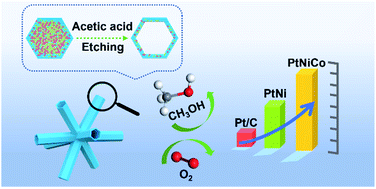Trimetallic PtNiCo branched nanocages as efficient and durable bifunctional electrocatalysts towards oxygen reduction and methanol oxidation reactions†
Abstract
Engineering the composition and structure of Pt-based alloy electrocatalysts has exhibited great promise for enhancing activity and durability in the oxygen reduction reaction (ORR) and methanol oxidation reaction (MOR). However, it remains a great challenge to completely achieve this goal because of sluggish kinetics and surface CO poisoning. Herein, we successfully constructed trimetallic PtNiCo branched nanocages via a simple etching treatment. The trimetallic PtNiCo nanocages exhibited outstanding activity and durability in both acidic ORR and MOR. Strikingly, the mass activity of the catalyst in ORR and MOR reached 1.03 A mgPt−1 and 2.82 A mgPt−1, with 13.8- and 5.6-times enhancement of specific activity compared to Pt/C. Detailed investigations reveal that the most optimized electronic structure for the d-band center (a 0.17 eV downshift compared to pure Pt) by the alloying effect of Co and Ni contributed to the enhanced performances and great CO-tolerance of such unique Pt-based catalysts, which provide a new perspective for designing high-performance electrocatalysts for commercial fuel cells.

- This article is part of the themed collections: Journal of Materials Chemistry A Lunar New Year collection 2022, Journal of Materials Chemistry A HOT Papers and 2021 Journal of Materials Chemistry A most popular articles


 Please wait while we load your content...
Please wait while we load your content...